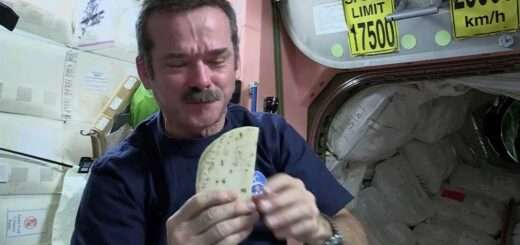The UAE’s Martian City on Earth
The United Arab Emirates is really good atenormously ambitious — and just physicallyenormous — projects. From the Burj Khalifa to their artificialislands, to the mountain they want to build,to that giant indoor ski resort they have:the UAE is about pushing the limits of engineering,sometimes out of necessity, and sometimesbecause they’re just feeling it. And now they’re taking that feeling andrunning with it to Mars, in the form of agiant Martian colony. But first, they’re planning to build a modelcolony here on Earth — the biggest Marssimulation anyone has ever done. In 2014, the UAE established their space programand announced their inaugural mission: theAl-Amal, or Hope, orbiter, which will monitorMars’s atmosphere and weather. Mars’s atmosphere used to be much thicker,and the causes of its thinning aren’t entirely known. The planet’s lack of magnetic field probablyplays a role, but we don’t have any definitiveanswers to the question yet. So with Hope, they’re … hoping … toanswer that question. It’s set to launch in 2020 and arrive atMars in 2021. But the UAE is thinking really long term aboutMars, and also has plans to build a wholecity up there. They want to get 600,000 people living onMars. That’s super ambitious, especially consideringwe haven’t sent anyone to Mars yet, buttheir deadline is 100 years from now, so theydo have plenty of time to figure it out. And that’s where their most recent Mars-relatedproject comes in: a smaller, model colonyin the Emirates. And when I say “smaller,” all I mean isthat It’s not going to be nearly as bigas the actual planned colony on Mars. It’ll still be pretty darn huge — abouttwo-tenths of a square kilometer in area,or about half the size of the Vatican. And the whole thing is going to be coveredwith domes!It won’t be the first simulated Mars habitat,although it will be the biggest. The Mars Society runs two habitats, in Utahin the US and Nunavut in Canada. And the University of Hawaii has one too. All of these simulations are places for teamsof scientists to conduct astrobiological andgeological research in environments that area lot like Mars. And at the same time, they can simulate therealities of living in a scientific settlementon a planet that can’t support you. There tend to be lots of rules: you can’tgo outside of your living space without wearinga spacesuit; your water use is extremely well-regulated,and you can’t communicate off-base withouta 20-minute delay. The habitats allow scientists to work on theirown projects there, while simultaneously beingpart of a long-term psychological experiment:how will scientists fare when stuck in a littlehab together?How do we meet their psychological and emotionalneeds?The UAE’s environment will work on answeringsimilar questions by having a crew live intheir habitat for a year. But it’ll also be a sandbox for engineersto test the kinds of systems they’ll needto support a long-term settlement on Mars,something we haven’t really been able todo before on such a large scale. Everything is still very conceptual at thispoint — the UAE Space Agency hasn’t evensaid when they’re planning on having thisthing built. But they have released some very preliminaryplans for their Dome-inion. That’s not the official name, we’re justreally hoping it catches on. The colony will be contained inside threedomes, and it’s going to be really crucialto get those domes right. Earth’s atmosphere filters out lots of UVradiation from the sun, but Mars’s atmosphereisn’t thick enough to do that. Which means people on the surface would faceeverything from bad sunburns to skin cancerunless they’re protected. In theory the domes are going to do the jobthat Mars’s atmosphere can’t, and will bemade out of a material that can shield inhabitantsfrom Mars’s high UV flux. Based on some of the concept art they’vedrawn up, it might also be possible to controlhow much light the material lets through,which would be a way to have the people andplants in the model city living on Martianday/night cycles. No word on what this material is yet, butagain, they have a while to figure it out. Since the whole thing will be enclosed, engineerswill be able to test the atmospheric regulationsystems, water filtration systems, temperatureregulation systems — all the usual mechanicalstuff that you need to survive when your environmentcan’t support you. And they’ll be developing these systemsto accommodate a small city, rather than justa li’l habitat or a space station, so it’sa big challenge!But probably the biggest problem engineerswill have to solve is how to feed everyone. For a permanent or semi-permanent colony,you can’t rely on shipments of food from Earth. And while Mars’s soil does contain some ofthe elements and molecules that plants needto grow, they’re not abundant enough toreally support agriculture. So we’ll have to apply everything we knowabout agriculture to this new environment,which is okay because if humans know how todo anything, it farming. We are so good at that. It’s kind of our thing as a species. That and long-distance running and fully rotatablearms. Anyway, farming: we’re really good at it,especially since we’ve figured out how tomanipulate genes. Genetically modified plants that can thrivein relatively nutrient-poor soil or producehigher amounts of proteins, carbs, or essentialvitamins already exist, and of course we haveall kinds of fertilizers, both natural andsynthetic. So a lot of the foundation work is done there— but we are still a long way from beingable to farm in such an extreme environmentas Mars. Even with plenty of potatoes and poop. In addition to all the research going on inthe Dome-inion, they’re also planning onbuilding a museum in there, with walls 3D-printedfrom local sand. The museum will celebrate the history of humanspaceflight, and who knows — maybe by acentury from now, it’lll inspire 600,000people to pick up their lives and fly to another planet. Thanks for watching this episode of SciShowSpace!To learn more about other plans to help uslive on Mars, you can check out our episodeabout the plans for Mars One.













